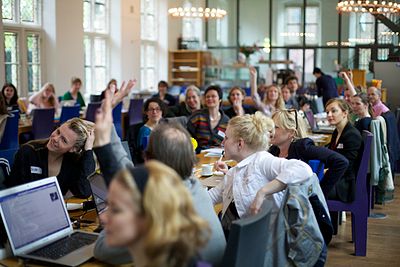Wikimedia Blog/Drafts/Europeana Fashion Handbook to Bring Wiki and GLAMs Together
|
This page is currently a draft. More information pertaining to this may be available on the talk page. Translation admins: Normally, drafts should not be marked for translation. |
Europeana Fashion Handbook to Bring Wiki and GLAMs Together[edit]
In an effort to improve fashion knowledge on the web, Europeana Fashion has organized a series of edit-a-thons with Wikimedia volunteers and fashion institutions around Europe. The experience and knowledge gained from these events are now compiled in one handbook, The Europeana Fashion Edit-a-thon Handbook for GLAMs.

What is fashion? Fashion is vanity, fashion is business, fashion is art. Fashion can mean many things to many people, but what is certain, is that it has enormous cultural significance. Every item of clothing has its roots in history and carries a symbolic meaning in the present.

Take, for example, the most basic of garments, the T-shirt. It was originally designed as an undergarment in the American army in the early 20th century. In the 1950s it became part of the uniform of rebellious youth culture and was seen on the likes of Marlon Brando and James Dean. Nowadays, the T-shirt is worn everywhere with everything, even under a suit. From underwear, to act of rebellion to formal, fashion objects can be considered artifacts of past and present.
That is why there are public and private institutions collecting fashion. Europeana Fashion aims to bring all these collections together in one online portal and improve knowledge around these collections.
The best way to improve knowledge online is through Wikipedia. It’s open, free and one of the most visited websites. In an effort to get communities and institutions involved, Europeana Fashion hosted multiple Wiki edit-a-thons.

After setting up seven edit-a-thons in five countries in one year’s time, the project bundled its experiences in a handbook for organizing fashion edit-a-thons. It is directed towards galleries, libraries, archives and museums, or in short: GLAMs. The handbook is available online and open to improvement from the community.
Engaging Fashionistas[edit]
Fashion carries with it very relevant cultural, historical and symbolic meaning. However, despite its social significance, fashion’s presence on Wikipedia is not as comprehensive as it should be. This encouraged Europeana Fashion to partner with Wikimedia volunteers in an effort increase fashion knowledge and open multimedia in the Wiki world.
Twenty-two partners from twelve European countries work together on the Europeana Fashion portal. Together, these institutions collect and make available thousands of historical dresses, accessories, photographs, posters, drawings, sketches, videos and fashion catalogues. At the same time, it makes these items findable through Europe’s online cultural hub Europeana. Europeana Fashion invited its partners to make available their collections on Wikimedia Commons and welcomed users to write about their collections. The aim: to enrich and share the knowledge about these objects and improve the existing knowledge about fashion’s history, origins and trajectory on Wikipedia.
A Handbook for GLAMs[edit]
The Fashion Edit-a-thon Handbook for GLAMs is a best-practice work, written by members of the Europeana Fashion team and composed of knowledge gained after organizing seven fashion edit-a-thons in Sweden, the Netherlands, Italy, Belgium and Israel.
The handbook primarily compiles what we have learned from running these events. It has been reviewed and amended by the Europeana network and Wikimedia community. It provides an overview of Wikimedia, Wikipedia, Wikimedians, the basics of hosting an edit-a-thon, ways to ensure a successful edit-a-thon, how to measure success, tips for getting content on Wikimedia, event promotion, as well as a suggested day programme, a 3 month preparation agenda and an abundance of relevant links. The final result is a reference guide that any GLAM institution hoping to hold an edit-a-thon can utilize.

Promoting "Open”[edit]
Europeana Fashion not only wants to improve knowledge around fashion, it also wants to set an example and influence cultural heritage institutions to open up their collections. Improving cultural heritage knowledge on Wikipedia is an incredibly important aim.
We hope to close the gap between institutions and volunteers in their willingness to learn and change. This handbook, while not exhaustive, is a step towards promoting more collaboration between Wikimedia and fashion institutions (or any GLAM, for that matter).
In an effort to keep the collaboration on-going and beneficial to all we have written in a few questions at the end of the handbook. These are to be answered by any institution who uses it for an edit-a-thon so that everyone can continue to learn from one another. This handbook hopes to become an intermediary to help with GLAM-wiki relationships and lead to more open collaborations.
You can download the Fashion Edit-a-thon handbook here.
--80.79.39.125 08:32, 7 April 2014 (UTC)Gregory Markus, Project Assistant Europeana Fashion via Nederlands Instituut voor Beeld en Geluid
